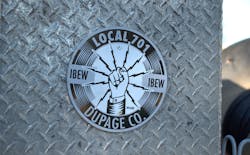IBEW-Backed EV Training Picked for National Charging Network
International Brotherhood of Electrical Workers may deepen its involvement in expanding the network of electric vehicle charging stations in the US with an announcement from the Department of Transportation that the EV infrastructure training programs preferred by the labor union will be the preferred national standard for worker training.
The IBEW, which represents about 775,000 electrical workers, developed the Electric Vehicle Infrastructure Training Program along with industry partners about 10 years ago as a standard for training and certification for the workers who install and maintain charging stations, according to a press release by IBEW.
“We’ve consistently touted our highly skilled, highly trained workforce as leaders in installing and maintaining EV charging infrastructure, and we’re very pleased that the DOT is putting its faith not just in the program, but also in the skills that make our electricians the best qualified men and women to help build a quality and reliable national charging network,” said IBEW President Lonnie R. Stephenson.
The program was written along with several stakeholders across the manufacturing, utility and automotive sectors, including educators as well as the National Electrical Contractors Association.
The Electrical Training Alliance, which oversees and develops curricula for the IBEW’s joint apprenticeship training centers, estimates that more than half of the IBEW’s roughly 270 inside wire worker JATCs in the U.S. are actively enrolling students for electric vehicle charging system training programs.
“The rapid adoption of electric vehicles hinges on the safe, orderly build-out of charging infrastructure,” Stephenson said. “Proposing the EVITP as the required certification, something that the IBEW already offers, is a huge win for our members.”
President Joe Biden and the $1 trillion infrastructure law propose a $5 billion, 500,000-station national charging network to be built by IBEW members.
According to IBEW, federal agencies like the DOT have the authority to create rules to help implement laws like the infrastructure law, and guidance the agency released earlier this year strongly encouraged jurisdictions to consider using the program when applying for a share of the funding.
As written, the rule requires journey wire workers who install, maintain and operate EV service equipment be certified through the program. It also mandates, for projects where more than one electrician is needed, that at least one be an apprentice in a registered electrical apprenticeship program.
According to the Federal Highway Administration, jurisdictions can meet the requirement through another appropriate registered apprenticeship program, but states that the EVITP would be the preferred one.
Electricians must be licensed or certified by the states where they live to be eligible for the program, and if their states do not license or certify, then they must prove that they have had at least 8,000 hours of hands-on electrical construction experience.
The Department of Energy estimates that there are already about 43,000 charging stations installed across the country. The National Electric Vehicle Infrastructure Formula Program aims to add 500,000 more by 2030, in locations no more than 50 miles from each other and near rest areas and off-ramps and rest areas along designated alternative fuel corridors.
About the Author
Jeff Postelwait
Managing Editor
Jeff Postelwait is a writer and editor with a background in newspapers and online editing who has been writing about the electric utility industry since 2008. Jeff is senior editor for T&D World magazine and sits on the advisory board of the T&D World Conference and Exhibition. Utility Products, Power Engineering, Powergrid International and Electric Light & Power are some of the other publications in which Jeff's work has been featured. Jeff received his degree in journalism news editing from Oklahoma State University and currently operates out of Oregon.
